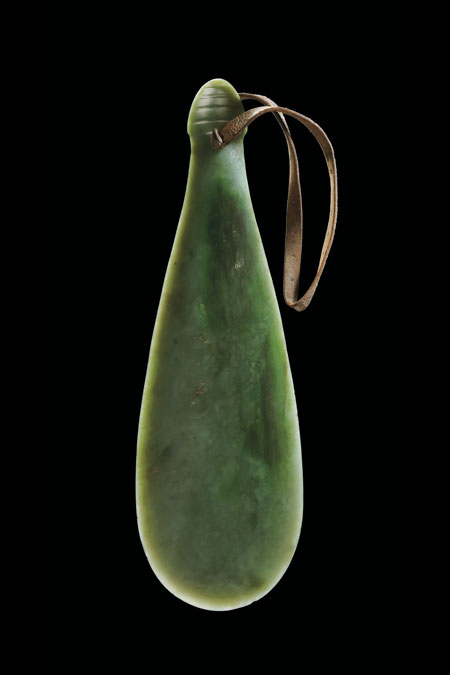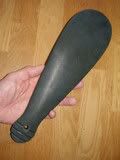Edward Shortland bereiste in jenem Jahr die Südinsel Neu Seelands und hat so manches interessantes beobachtet.
Auf der Südinsel an der Westküste gibt es nennenswerte Vorkommen von Nephrit-Jade und Bowenit, Mohs`sche Härte 6 – 6,5. Er beschreibt sehr anschaulich den Besuch in einer Steinbearbeitungs-Werkstatt.
"The Southern Districts of New Zealand : a Journal, with Passing Notices of the Customs of the Aborigines
Author: Edward Shortland
Publication details: Longman, Brown, Green and Longmans, 1851, London "
Quelle: http://www.nzetc.org/tm/scholarly/tei-S ... d1-d1.html
S. 33
“This weapon is to the natives as great a treasure, as any of the most precious stones are to us. It is thought worthy to be distinguished by a name, as was King Arthur's sword “Caliburn,” and is handed down, an heir-loom, from father to son. I will therefore give some description of it, and of the stone from which it is fabricated.
S. 34

In the northern island it is called a “patu-pounamu” or “meri-pounamu.” A very celebrated one which I saw in the possession of Te Heuheu, at Taupo, was of the form here represented, about twenty inches long, the blade about four inches wide, and three-fourths of an inch thick in the middle, tapering on either side to a tolerably sharp edge. The stone was of a pale green colour, mixed with opal, so as to present a wavy appearance, like that of a mackerel sky, translucent at the edge, and not disfigured by a single black speck. This weapon was named “Kaiarero,” and was obtained from a chief of the east coast, whom an ancestor of Te Heuheu had killed in battle.
S. 117
“Here I saw for the first time, on a large scale, the native method of grinding the “pounamu” or green stone, from the rough block into the desired shape. The house belonging to the chief, Koroko, was like a stone-cutter's shop. He and another old man were constantly to be seen there, seated by a large slab of sandstone, on which they by turns rubbed backwards and forwards a misshapen block of pounamu, while it was kept moist by water, which dropped on it from a wooden vessel. While one rubbed, the other smoked. They made, however, so little progress on it during my stay, that it seemed probable it would be left for some one of the next generation to finish the work. It is not, therefore, to be wondered, that what has cost so much labour, should be regarded as the greatest treasure of the country.
S. 118
Here also I saw the drill, with which holes
.jpg)
are bored through this stone. It is formed by means of a straight stick, ten or twelve inches long, and two stones of equal weight, which are fastened about its central point, one on either side, opposite each other, so as to perform the office of the fly-wheel in machinery, and to exert the required pressure. One end of the stick, or, as we may call it, shaft of the instrument, is applied to the pounamu where the hole is to be bored. Near the other end are tied two strings of moderate length. One of these is wound round the shaft, close to the point of its attachment, and its extremity is held in one hand, while the extremity of the other string is held in the other hand. A motion is now given by pulling on the former string, which, as it unwinds, causes the instrument to revolve, and the other string becomes coiled round the shaft: this is then pulled on with a similar result; and so the page
S. 119
motion is kept up by alternately pulling on either string. The point of the instrument can thus be made to twirl round, backwards and forwards, as rapidly as the point of a drill, moved by a bow; and merely requires to be constantly supplied with a little find hard sand and water, in order to eat its way through the pounamu or other stone, on which steel would make no impression.”
Guckle-Übersetzer:
Hier sah ich zum ersten Mal im großen Maßstab, die native Methode zum Schleifen der "pounamu" oder grünem Stein, aus dem rohen Block in die gewünschte Form. Das Haus gehört dem Chef, Koroko, war wie ein Steinmetz-Werkstatt eingerichtet. Er und ein anderer alter Mann waren ständig dort zu sehen sein, bei eine großen Platte aus Sandstein, auf der sie abwechselnd einen unförmigen Block pounamu hin und her rieben, während es feucht gehalten, indem Wasser, das auf sie aus einem hölzernen gesunken Gefäß. Während einer rieb, rauchte der anderen. Sie machten jedoch so wenig Fortschritte während meines Aufenthaltes, in dem es wahrscheinlich schien es für einige eine der nächsten Generation an die Arbeit zu beenden bleiben würde. Es ist daher nicht zu verwundern, dass das, was so viel Arbeit kostet, als der größte Schatz des Landes betrachtet wird.
Auch hier sah ich den Bohrer, mit denen Löcher
werden durch diesen Stein gebohrt. Es wird durch einen geraden Stock, 25 oder 30 Zentimeter lang und zwei Steine mit gleichem Gewicht, die über ihre zentralen Punkt, einer auf jeder Seite, einander gegenüber befestigt sind, so dass das Büro der Durchführung fly-Rad in Maschinen, auf und üben den notwendigen Druck. Ein Ende des Stockes, oder, wie wir es nennen, Schaft des Instruments ist es, die pounamu, wo das Loch ist gebohrt zu werden angewendet. In der Nähe der anderen Seite sind zwei Fäden von mittlerer Länge gebunden. Eines davon ist umwunden der Welle, in der Nähe der Stelle ihrer Befestigung und ihre Extremität in einer Hand gehalten, während die Extremität der anderen Zeichenfolge in der anderen Hand gehalten wird. Ein Antrag wird nun durch Ziehen an der ehemaligen String, der, wie es rollt, bewirkt das Gerät zu drehen, und die andere Zeichenfolge wird aufgerollt rund um die Welle gegeben: dieses wird dann auf ein ähnliches Ergebnis gezogen, und so die Seite Bewegung wird durch abwechselndes Ziehen an einem der Strings gehalten. Der Punkt des Instruments kann somit zu drehen Runde geschafft werden, hin und her, so schnell wie die Spitze eines Bohrers, bewegt durch einen Bogen, und erfordert lediglich, ständig mit ein wenig schwer zu finden Sand und Wasser, um zu liefernden essen seinen Weg durch die pounamu oder anderen Stein, auf dem Stahl keinen Eindruck machen würde. "

(Quelle: http://www.teara.govt.nz/en/pounamu-jad ... nstone/5/2)
Hier lässt sich zoomen um einen Eindruck der Durchlochungen zu erhalten:
http://collections.tepapa.govt.nz/Objec ... ?oid=71840
Wiki:


Gruß Marquardt
Ich musste mir einfach einen Rohling besorgen:



 ) RESPEKT!!!
) RESPEKT!!!